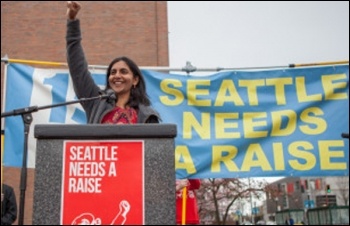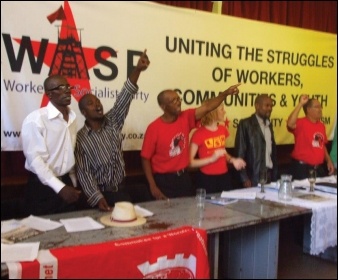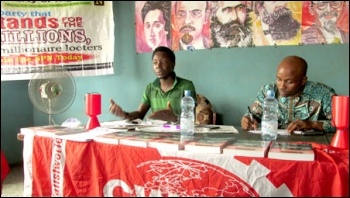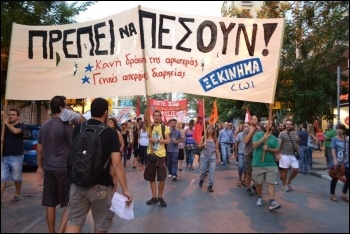40 years of the Committee for a Workers’ International
Socialism and internationalism
International solidarity is a vital aspect of the struggle for socialism. The Socialist Party fights for a world free of poverty, war and inequality. But that requires more than just supporting workers in struggle in other countries, important though that is. We need to build a powerful international organisation, capable of helping the working class to replace the capitalist system with democratic socialism. To aid this task the Committee for a Workers’ International (CWI) was founded at a meeting of 46 comrades from 12 countries on 21 April 1974. Today it spans 48 countries on every continent.
Robert Bechert of the International Secretariat of the CWI, one of those at its founding meeting, explains the need for an international in the 21st century.
Since the beginning of the 20th century every decade has witnessed revolutions as the working and poor masses attempt to end the oppression and exploitation they suffer under capitalism. There have also been mass struggles, counter-revolutions and mighty, world changing, developments.
The past 40 years have been no exception. A mere four days after the CWI’s formation, 48 years of military and dictatorial rule in Portugal ended with the 25 April revolution. A few months later the Greek military junta collapsed. But history does not develop in a straight line. In both countries the ruling classes were able to survive to defend their system mainly because the mass movements that threatened them did not have a concrete strategy of how to replace capitalism, and a leadership prepared to lead that battle.
Capitalist crisis
The past 25 years have been complicated by the collapse of the Soviet Union and the other Stalinist states. Being ruled by a privileged totalitarian elite meant that these states could not be regarded as socialist. However, the fact that these states rested on a planned, nationalised non-capitalist economy meant that their very existence proved that capitalism was not the only possible system.
The post-1989 collapse of these states into capitalism was utilised by the ruling classes in their counter-offensive after the radicalisation of the 1960s to 1980s to ideologically claim that there was no alternative to capitalism. This helped accelerate the rightward, pro-capitalist move in much of the labour movement.
But since the 2008 onset of the latest crisis in global capitalism we have entered a new world period. In many countries, especially the main imperialist ones, capitalism means living standards have fallen or are still falling. However, an important feature today is that a combination of globalisation and communications’ innovation has strengthened an international consciousness.
Growing numbers see the questions of the economy, war and peace, and the environment as international and also as tied to capitalism, or at least to the domination of the giant financial, manufacturing and trading corporations. At the same time more people are aware of the possibilities inherent in scientific and technological advances if they are utilised in the interests of the population and the environment rather than corporate profit. But most importantly, the experience of austerity and the struggle against it is forging an understanding of the need to change society fundamentally. Thus events like the 2011 overthrow of Egyptian dictator Mubarak had a worldwide impact.
These developments have provided an important potential base for an international socialist organisation, linking together movements around the globe. This century has already seen international movements and struggles, such as the opposition to the US and British led invasion of Iraq, the worldwide Occupy/Indignados protests, the anti-austerity protests in Europe, the impact of the 2011 Tunisian and Egyptian revolutions and the recent international dock workers’ struggle.
Building a new international
But if the workers’ movement cannot provide a concrete answer to today’s issues then there is the danger that reactionary nationalist ‘answers’ can gain support, laying the basis for future chauvinist or ethnic conflicts within and between states. One of the objectives that the CWI has set itself is to help arm the workers’ movement with a programme and strategy to both win our immediate battles and to remove capitalism’s poisonous grip over the world, starting with explaining the central role of the working class.
It was not accidental that the foundation of the CWI took place in a very turbulent and radical period. The long post-World War Two economic upswing was ending. But already, before the 1973 oil crisis that came to symbolise the changing economic situation, Europe and then Latin America had been gripped by revolutionary movements and crises. In Vietnam, US imperialism was facing its first ever military defeat. The Stalinist regimes had been shaken by the 1968 ‘Prague Spring’ in the then Czechoslovakia and the 1970/71 wave of workers’ strikes in Poland, movements which were not pro-capitalist but in essence looking towards establishing a workers’ democracy.
At that time the trade unions in Britain were at a high point, but not just in terms of numbers. The miners’ victories and the 1974 defeat of the Tory government in the “who runs the country” election showed their potential strength.
The onset of a generalised capitalist crisis deepened a political radicalisation in the workers’ movement in many countries. The bitter experience of the bloody 1973 overthrow of the Allende government in Chile provoked a wide discussion on how socialism could be achieved and also how to prevent counter-revolution blocking the labour movement’s path. It was truly a period of international struggle.
In 1974 the Spanish dictatorship of Franco, faced with a developing revolution, was crumbling. But the Spanish ruling class sought, and obtained, the help of the workers’ leaders to contain the revolutionary movement and was able to establish a capitalist democracy.
Against this background Marxists, then around the Militant, the forerunner of the Socialist, had begun to reach a much wider audience in Britain and in other countries. This was mainly in Europe but also in Sri Lanka where the history of a Trotskyist movement with mass support meant that our ideas found an early echo.
But after the experiences of the Socialist and Communist Internationals, the idea of an international workers’ organisation that struggles, that goes beyond solidarity, became less central to the workers’ movement. But in the 21st century all these issues are again posed sharply.
Experience has shown, however, that protests alone can win individual demands but not fundamentally change the situation. For that a movement needs a concrete programme of action and a clear-sighted leadership.
Today the capitalists have little optimism. They lack confidence, as revealed in their discussions on whether they can stop funnelling money into many economies via Quantitative Easing (QE) and, if they do, what will be the effects?
These conditions are preparing new periods of struggle and revolution. Generally in this period of crisis most struggles have been defensive, against the ruling classes’ onslaught, but in countries which have seen economic growth, like Brazil and China, there have been offensive battles to win improvements.
Opportunities
In Greece the workers have conducted an incredible 36 general strikes since 2010, but have not been successful in stopping the ruling class’s onslaught. But this does not rule out a new radicalisation, perhaps initially on the political plane. All the time sections of the movement are drawing lessons from their experience.
The revolutions and mass struggles of recent years have again posed the age old question of how can gains be consolidated and the old order really removed? Egypt is the latest example of where, in February 2011, the working masses potentially had power in their hands but did not fully understand that or see what needed to be done.
Mighty revolutions can almost completely sweep away the old order but, as in Portugal after 1975, it can come back if the working class does not secure power. Obviously every revolution and struggle has its own characteristics, but in revolutions the general lesson of how the working class and poor in Russia were able to come to, and stay in, power in 1917 is still essential.
Today’s situation is similar in some ways to the late 19th century when the mass workers’ movement developed. Now it is a question of re-building or building afresh workers’ organisations. A complication is that, in many countries, workers have the bitter experience of the decay or collapse of the old workers’ organisations, with especially the former social democratic, socialist and communist parties now mostly being transformed into pro-capitalist or totally capitalist organisations.
The CWI is, in many countries, playing a key role in this rebuilding and, where appropriate, arguing that a start must be made to create new political parties of the working class as a step towards building a mass socialist workers’ movement. But it is not just propaganda. In Britain, South Africa and Nigeria we have been instrumental in steps being taken to form new parties. In Ireland, the USA and Sweden, CWI comrades currently fight elections under their own banner.
Where left parties exist, like PSoL in Brazil and Die LINKE in Germany, CWI comrades are active in them while also arguing what steps need to be taken to further build them as socialist organisations. This is part of our CWI tradition. From our beginning we have not been passive – participating in and initiating struggles, big and small.
But in many ways these first four decades of the CWI are really only a pre-history. We are already in a tumultuous period, everything is either being questioned or soon will be. The experiences of this period of capitalism, the growing environmental crisis, with no future on offer to the vast mass of young people, will produce revolutionary storms. The CWI will play a full part in these events, including the building of a movement that can finally end this brutal, chaotic and unfair capitalist system and make life a pleasure for all.
Workers of all countries, Unite!

Karl Marx
In 1848 Karl Marx and Friedrich Engels explained in the Communist Manifesto that “modern industry has established the world market… The bourgeoisie has through its exploitation of the world market given a cosmopolitan character to production and consumption in every country… In place of the old wants, satisfied by the production of the country, we find new wants, requiring for their satisfaction the products of distant lands and climes. In place of the old local and national seclusion and self-sufficiency, we have intercourse in every direction, universal inter-dependence of nations.”
For socialists and working class activists Marx and Engels’ conclusion was that, in the face of an international capitalist system, the need was for “Workers of All Countries, Unite!”
The First International, founded in 1864, brought together the different forces in the then newly arising workers’ movement and helped give them a firm political basis. It collapsed in 1876 in the aftermath of the crushing of the Paris Commune.
But in 1889, a new International was formed. This body, later called the Second International, soon came to symbolise a dramatic growth of workers’ organisations and a popularisation of socialist ideas – most formally accepted Marxism as their political basis.
But political debate continued and repeatedly centred on the question of whether to attempt to reform capitalism or overthrow it. While some, especially rank-and-file reformists, may have genuinely believed that this was an easier way to change society and achieve socialism, for the growing number of leaders this policy marked their own personal adaptation to capitalism.
1917 changes situation
This reflected the contradictory fact that the growth of a powerful workers’ organisation while obviously strengthening workers’ ability to struggle also posed the danger of giving birth to conservative strata, enjoying comfortable careers. They were increasingly reluctant to challenge capitalism.
But it was only with the outbreak of World War One that the strength of the pro-capitalist elements at the top of the workers’ movement was clearly revealed. The overwhelming majority of Second International leaders supported their ‘own’ ruling classes and empires. This was a fundamental break with the principles and decisions of the International to oppose a war between the competing imperialist powers. While in Russia and a few other countries socialist parties opposed the war, in most combatant countries only small minorities opposed the war in 1914.
This, combined with helping to suppress revolutionary movements in their own countries, transformed the workers’ movement.
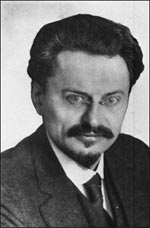
Leon Trotsky
Against this background the socialists who refused to accommodate themselves with capitalism argued that it was necessary to fight to free the workers’ movement from this influence. The victory of the October revolution in Russia in 1917 transformed the situation. The German revolutionary Rosa Luxemburg summed up the feeling of many activists and workers around the world that the Bolsheviks, “Lenin and Trotsky and their friends” set “an example to the workers of the world”.
The example was both political – programme, strategy and tactics – and organisational, in the sense of building workers’ organisations that were willing and able to fight to end capitalism. The subsequent struggle in the workers’ movement was fierce, sometimes bloody as the pro-capitalist elements sought to drive out, and sometimes even murder, the left.
Internationally this split was seen in the 1919 formation of the Communist International, an organisation then dedicated to overthrowing capitalism. It had a mass base in many countries as the events of 1917 in Russia sparked a mass revolutionary wave that travelled around the world. However the Communist International did not fulfil its early promise.
Stalinism falls
The defeat of post-World War One revolutions in Europe led to isolation of the Soviet Union. In post-war conditions of poverty, exhaustion and underdevelopment an increasingly privileged strata was, under the false banner of ‘protecting the revolution’, able to gradually consolidate its power and suppress democratic rights.
This was the basis for the rise of the Stalinist dictatorship which increasingly tried to avoid international upheavals or revolutions that could disrupt its rule. Thus, desperate to avoid war, it suddenly in 1939 signed a deal with Hitler, which included sending raw materials and returning German anti-fascist refugees to Nazi Germany.
But this did not, as Leon Trotsky wrote at the time, prevent a Nazi attack on the Soviet Union in 1941. Later, allied with the US and Britain, Stalin decided in 1943 to dissolve the Communist International as a way of showing that his regime was not seeking to overthrow capitalism internationally but rather seeking an accommodation with the main capitalist powers.
Trotsky, the co-leader with Vladimir Lenin of the Russian Revolution, who in the 1920s led the opposition to the rise of the Stalinist system, had already drawn the conclusion in 1933 that the Communist International was no longer capable of leading the struggle against capitalism. This was after the Nazis came to power in what was probably the worst defeat that the workers’ movement has ever suffered.
Thus, once again, the question of building a genuine international was posed. However, while Trotsky raised the banner and programme of a Fourth International in the 1930s, initially it was only in Ceylon/Sri Lanka, Vietnam and Bolivia that it attracted large forces, although in the 1930s and 1940s its activists played important roles in struggles in other countries. During the more difficult political period after the Second World War, political and organisational disagreements led to divisions within the Trotskyist movement. It was out of this development that the CWI was formed. Since then it has grown as individuals and groups have joined with us in the work to build an international socialist movement that can transform the globe.
In striving to achieve this aim we do not see past events as dead history. On the contrary, while paying tribute to past courageous working class struggles, we aim to learn, and apply, the real lessons of these events in the battles of today and tomorrow.



